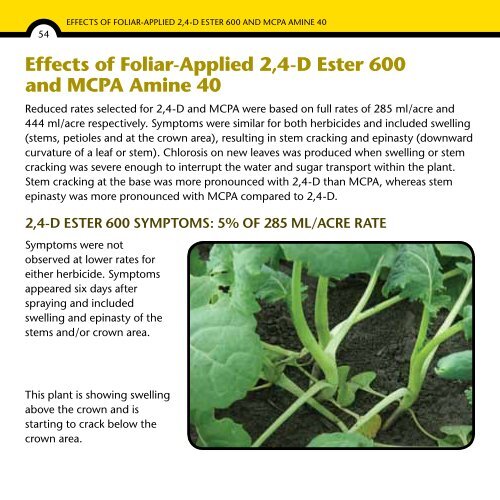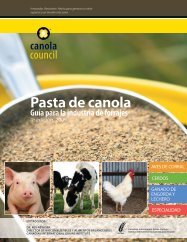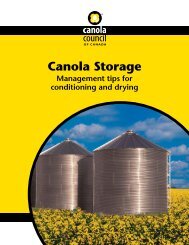Herbicide Residue Drift Injury - Canola Council of Canada
Herbicide Residue Drift Injury - Canola Council of Canada
Herbicide Residue Drift Injury - Canola Council of Canada
You also want an ePaper? Increase the reach of your titles
YUMPU automatically turns print PDFs into web optimized ePapers that Google loves.
54<br />
Effects <strong>of</strong> Foliar-Applied 2,4-D Ester 600 and MCPA Amine 40<br />
Effects <strong>of</strong> Foliar-Applied 2,4-D Ester 600<br />
and MCPA Amine 40<br />
Reduced rates selected for 2,4-D and MCPA were based on full rates <strong>of</strong> 285 ml/acre and<br />
444 ml/acre respectively. Symptoms were similar for both herbicides and included swelling<br />
(stems, petioles and at the crown area), resulting in stem cracking and epinasty (downward<br />
curvature <strong>of</strong> a leaf or stem). Chlorosis on new leaves was produced when swelling or stem<br />
cracking was severe enough to interrupt the water and sugar transport within the plant.<br />
Stem cracking at the base was more pronounced with 2,4-D than MCPA, whereas stem<br />
epinasty was more pronounced with MCPA compared to 2,4-D.<br />
2,4-D Ester 600 symptoms: 5% <strong>of</strong> 285 ml/acre rate<br />
Symptoms were not<br />
observed at lower rates for<br />
either herbicide. Symptoms<br />
appeared six days after<br />
spraying and included<br />
swelling and epinasty <strong>of</strong> the<br />
stems and/or crown area.<br />
This plant is showing swelling<br />
above the crown and is<br />
starting to crack below the<br />
crown area.











